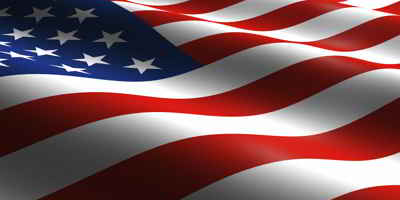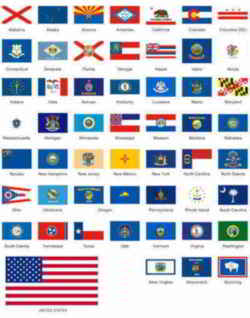

US Flag Presentation
Presentation
Presentation of the
Stars and Stripes or Old Glory
Adopted on June 14, 1777
Presentation of the flag during a ceremony should be preceded by a brief talk emphasizing the importance of the occasion. Following the presentation all present should salute the flag, recite the pledge of allegiance, and sing the national anthem.
Folding of Flag
- Two persons, facing each other, hold the flag waist high and horizontally between them.
- The lower striped section is folded, lengthwise, over the blue field. Hold bottom to top and edges together securely.
- Fold the flag again, lengthwise, folded edge to open edge.
- A triangular fold is started along the length of the flag, from the end to the heading by bringing the striped corner of the folded edge to meet the open edge.
- The outer point is turned inward parallel with the open edge, forming a second triangle.
- Repeat the triangular folding until the entire length of the flag is folded.
- When the flag is completely folded only the triangular blue field should be visible.
Care of Flag
The life of your flag depends on your care. Dirt can cut fabrics, dull colors, and cause wear. Most outdoor flags can be washed in mild detergent and thoroughly rinsed. Indoor and parade flags should be dry-cleaned. Many dry cleaners offer free cleaning of US flags during the months of June and July. Damaged flags can be repaired and utilized as long as the overall dimensions are not noticeably altered. American Legion Posts and local governments often have facilities to dispose of unserviceable flags. Store your flags in a well ventilated area away from any harsh chemicals or cleaning compounds. If your flag gets wet, never store it until it is completely dry. Wet folds cause permanent creases. Dampness ruins fabric and causes mildew. Pole care is also related to flag care. Rust and scale cause permanent stains and some metallic oxides actually eat holes in fabric.
Size of Flags
The size of the flag is determined by the exposed height of the flagpole from which it is flying. The only consideration is for the flag to be in proper proportion to its pole. Flags which fly from angled poles on homes and those which are displayed on standing poles in offices and other indoor displays are usually either 3' x 5' or 4' x 6'. Color guards usually carry flags measuring 4' x 6'. Other recommended sizes are shown in the following table:
| Flagpole Height (ft.) | Flag Size (ft.) |
| 20 | 4 x 6 |
| 25 | 5 x 8 |
| 40 | 6 x 10 |
| 50 | 8 x 12 |
| 60 | 10 x 15 |
| 70 | 12 x 18 |
| 90 | 15 x 25 |
| 125 | 20 x 30 |
| 200 | 30 x 40 |
| 250 | 40 x 50 |

The Flags of the US.





